Trajectory of Musashigawa Mitsuhide
Musashigawa Mistuhide
Born in 1971, from Hawaii.
He is now naturalized and his real name is Koyo Musashimaru.
He has a warm, cheerful and humorous personality, and loves Japan and sumo.
During his active days, he was known for his powerful sumo wrestling, with stable thrusts as his weapon, and during his time in the makuuchi era, he would sometimes send his opponents flying to the edge of the ring.
With the exception of the injury he sustained before entering the school, he has had no major injuries and has maintained stable results, with a total of 55 consecutive wins in 14 years (first place in history), and is from a foreign country, despite being crowded with talented players such as Takanohana, Wakanohana, and Akebono. He held the record for the most wins among sumo wrestlers, 12 times (at the time of his retirement; currently held by Hakuho).
After retiring, he served as Toshiyori under the name Musashimaru for five years, then worked as Toshiyori Furibu and Toshiyori Oshima, and is now the 15th Musashigawa, taking over the Toshiyori position from his predecessor, the 14th Musashigawa master. Succession of name.
He received the character “偉-hide-” from his predecessor, Musashigawa Akihide(武蔵川 晃偉), and decided to call himself Musashigawa Mitsuhide(武蔵川 光偉).
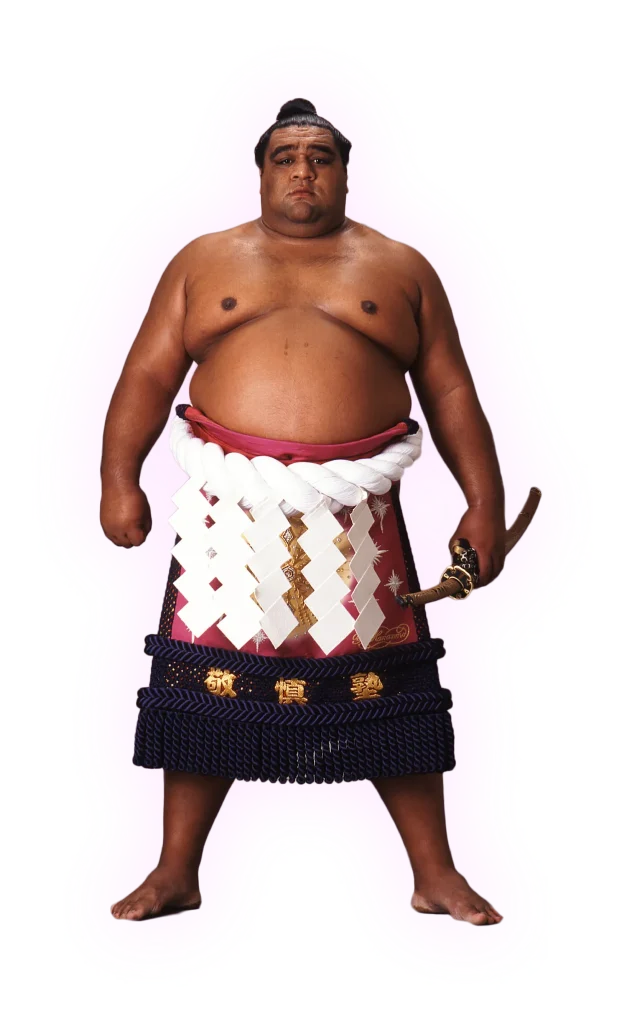
From childhood
to become a disciple
On May 2, 1971, Fiamalu Penitani was born in East Samoa, Oahu Island, Hawaii, United States. And He is Musashimaru, who later became a great yokozuna in faraway Japan.
“Ever since he was a child, he was a very akamai (Hawaiian word for “smart boy”),” said his mother, Nimala, of Fiamalu’s son.
He started playing American football in elementary school and played defense at Waianae High School, with the goal of becoming a professional NFL player.
He was recruited by universities as an American football player, but gave up on going to university due to financial reasons and dislike of studying.
He was also active in the Greco-Roman style (heavyweight) wrestling, and was recruited by universities in mainland America with scholarships.
However, he was introduced to the Musashigawa Stable by a Japanese wrestling gold medalist, and since he disliked studying, he decided to join the school and came to Japan to “use my body to help make ends meet.”
Her father, Manu, also told her, “God treats everything equally. There’s nothing to worry about. Fia, just move forward on your own path.” This also encouraged her to come to Japan.
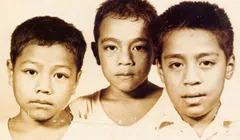
The clever-looking boy in the center is Fiamaru Penitani, who later became Yokozuna Musashimaru.
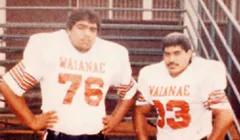
During my high school days, I spent my youth playing American football. On the left is young Fiamaru.
From apprenticeship
to makuuchi period
On June 30, 1989, Fiamaru, a boy who had just turned 18, landed at Narita Airport and entered Musashigawa Stable after a two-month training period.
During the two-month training period, he got used to the customs of sumo and learned Japanese.
In September of the same year, he stepped into the sumo ring for the first time.
After that, with his unique talent and effort, he overcame one difficulty after another and rose to the top without rest the Sumo tournament.
I only experienced losing once during the makushita era.
His name was `”Musashimaru, taken from his real name Fia’maru’.
He was promoted to “Makushita” as early as the 6th place from his sumo wrestler’s debut.
After that, after winning two “Juryo” championships, He rose to the top division for the Kyushu tournament in 1991.
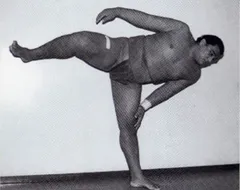
Showing off an splendid “Shiko” in a sumo wrestler’s debut.
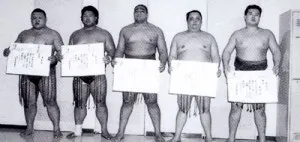
Won the 1990 summer tournament with “Sandanme”.
Promoted to Yokozuna
...and retirement
After rose to the top division, he received the Sukinari Bravery Award.
After that, he steadily rose through the rankings, and was already promoted to Komusubi in the summer of 1992.
In the fall of the same year, he was promoted to sekiwake. He was promoted to ozeki after his first tournament in 1994 at the age of 22 years and 8 months.
The statement at the Ozeki promotion transfer ceremony was
“I will dedicate myself to sumo with a Japanese heart.”
He became a lifelong rival with Takanonami, who was promoted to ozeki at the same time, and his 58 makuuchi matches were the most in sumo history.
Achieved his long-awaited first victory at the Nagoya tournament in 1994 while still an ozeki.
In 1996, he became a naturalized Japanese citizen and changed his real name to Musashimaru Koyo .
He won his fifth championship at the Nagoya tournament in 1999, and was promoted to yokozuna in his third attempt.
It took a longer journey than expected to become a yokozuna from ozeki, but expectations were high for the man who made the Japanese dream come true.
Musashimaru also lived up to these expectations, maintaining his status and honor as a yokozuna for a long time, and admirably fulfilling his role as a figurehead for the association.
Then, on the seventh day of the 2003 Kyushu Tournament, he was defeated by Tosanomi, and held a retirement press conference the next day.
At the press conference, he revealed for the first time that the pain in his left hand that directly triggered his retirement came from a neck injury he sustained playing American football in high school.
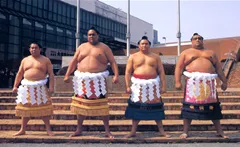
Four gorgeous shots of the spring tour of 2000, in which the retired Wakanohana joined as a thank-you servant.
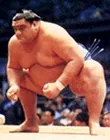
His weight at the spring tournament in 1996 was 206 kg.
For the first time, I exceeded the 200kg mark.
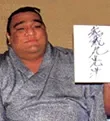
Establishment of a sumo stable
and guidance to the next generation
After retiring, he served as Toshiyori for five years under the name Musashimaru, then worked as Toshiyori Furiwake and Toshiyori Oshima, then took over the Toshiyori name from his predecessor, the 14th Musashigawa master, and in February 2013, became the Succeeded to the name of the 15th Musashigawa.
He received the character “偉-hide-” from his predecessor, Musashigawa Akihide(武蔵川 晃偉), and decided to Toshiyori name is Musashigawa Mitsuhide(武蔵川 光偉).
On April 1st of the same year, he opened Musashigawa Stable with two wrestlers and one Tokoyama as his apprentices.
(In 2010, the previous generation inherited the room from Master Fujishima and it became the Fujishima stable, so it was a de facto revival.)
He uses his strict but never emotional teaching methods to guide younger students.
In his private life, he married his wife Masami in April 2008. In June 2014, their first child, son Joey, was born.
In addition to his work as a master, he continues to work tirelessly to spread the appeal of sumo around the world, including as a committee member of the Japan Sumo Association, as a newspaper sumo critic.
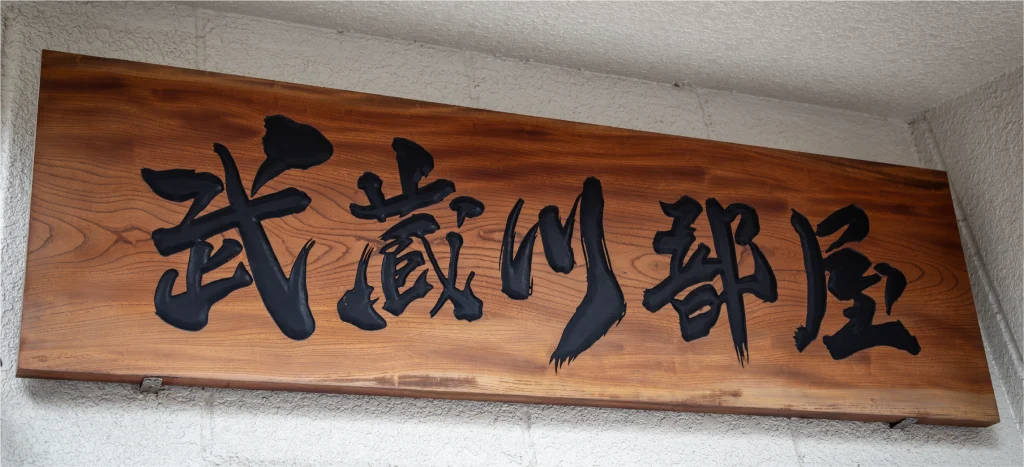
New room signboard when independent.
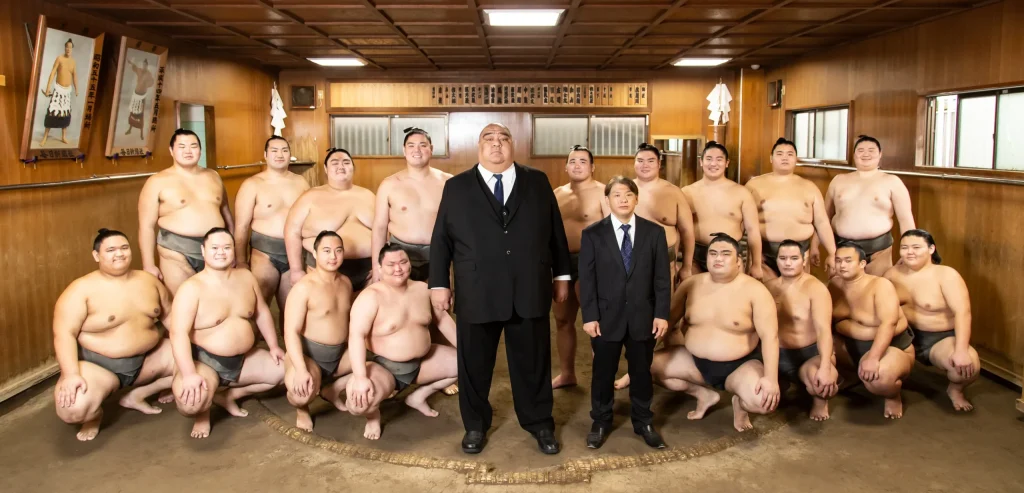
Surrounded by unique disciples.